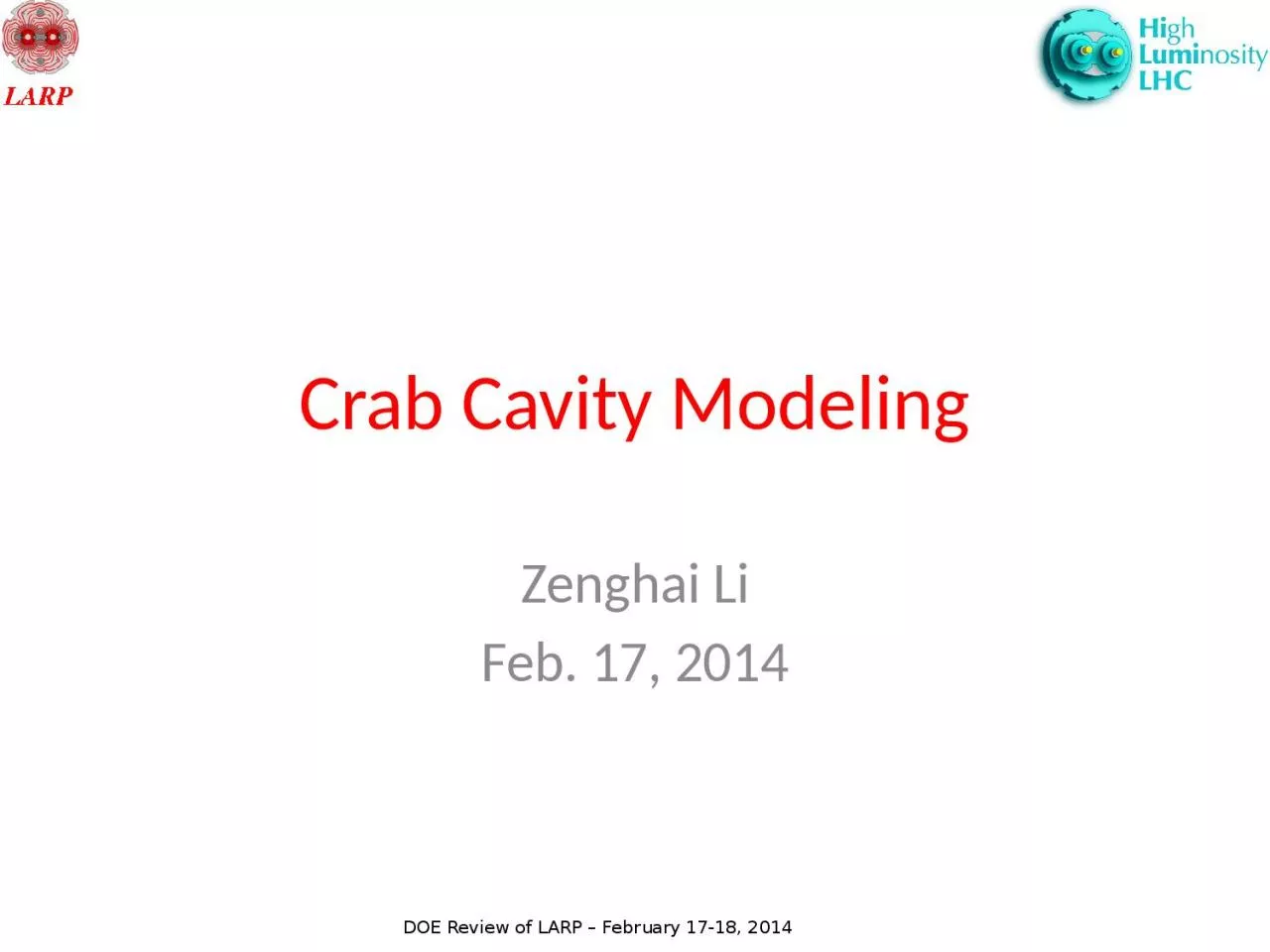

Feb 17 2014 Modeling Efforts Designoptimizationevaluation of two designs toward engineering realization RF Dipole RFD cavity Double Quarter Wave DQW cavity RFD cavity HOM coupler design improvement ID: 1042116
Download Presentation The PPT/PDF document "Crab Cavity Modeling Zenghai Li" is the property of its rightful owner. Permission is granted to download and print the materials on this web site for personal, non-commercial use only, and to display it on your personal computer provided you do not modify the materials and that you retain all copyright notices contained in the materials. By downloading content from our website, you accept the terms of this agreement.
1. Crab Cavity ModelingZenghai LiFeb. 17, 2014
2. Modeling EffortsDesign/optimization/evaluation of two designs toward engineering realization: RF Dipole (RFD) cavityDouble Quarter Wave (DQW) cavityRFD cavityHOM coupler design improvementImperfection studyRF pickup portRFD Lorentz force detuning calculationDQW cavityFPC/HOM portHOM coupler RF field evaluationHOM coupler Multipacting analysisHOM coupler damping evaluationSummary and Plan2
3. RFD, DQW ParametersRFDDQWFrequency (MHz)400400Operating ModeTE11Lowest dipole HOM (MHz)633683Lowest acc HOM715579Iris aperture (diameter) (mm)8484Transverse dimension (mm)281278/332Vertical dimension (mm)281278Longitudinal dimension (w/o couplers) (mm)556390RT (ohm/cavity)433428VT (MV/cavity)3.343.34Bs (mT)55.669.3Es (MV/m)33.439.6Deflect mostly by E fieldNo lower order modeCompactRFD DQWEB3
4. RFD Cavity with Couplers4HOM-vHOM-hFPCRF pickupOne HOM coupler for each planeSelective, no filter
5. RFD – HOM Couplers Improved to Damp a few “problematic” Modes Horizontal HOM coupler – moved up the starting position of the ridged gapVertical HOM Coupler – simplified wg stub, pickup coax moved toward the symmetry planeNo field enhancement in couplers5Older designImproved design(two modes have high impedance)
6. Effective Damping Achieved for All HOMs up to 2 GHzQext of modes at 1.265 and 1.479 GHz lowered by more than 10XOther modes remain well dampedEngineering design for the SPS test cavity 62 vertical modes with improved Qext
7. HOM Coupler with MP SuppressedSignificant MP in the ridged gap region (flat, smooth surface)(incomplete data)MP continues to higher deflecting voltagesMP region at a lower voltage MP region moves upward at high voltagesridged gap with a larger curvature small bump on one side of gapMP suppressed with a small bump on gap surface7
8. Wall Loss in NC WG Section vs Position of SC to NC Transition Evanescent field in horizontal HOM coupler causes residual power loss to the NC portion of the waveguideFlange location, gasket heating, cooling, etc.y8
9. 9FPC Coupler113mmHOM-hHOM-vFPCOD: 62 mmID: 27 mmInner conductorytipSatisfy interface requirementNo field enhancement at coupler portMP suppressed
10. 10Effect of Dipole Pole Tilt and OffsetXtiltytiltzrotatexoffsetyoffsetzoffsetImperfection models studied
11. 11Multipole Field with a Tilted/Offset Pole Small effects on multipole fieldsInduce skew sextupole and deflection in other planeCause shift in electric centerIn general, tolerance manageable
12. Lorentz Force DetuningFrequency shift due to shape deformation by RF field pressureCalculated using ACE3P multi-physics solver12E FieldB FieldMesh (material)Ports free: dF = -3286 Hz/3.5MVPorts fixed: dF = -3190 Hz/3.5MV
13. Pickup Port1) Suba’s pickup probe modelPickup port inside He vesselQ_pickup = 1.5e10P_pickup/3.5MV = 1.95W2) Shorter stubPickup port outside of He vessel (8-mm space between vacuum walls of stub and pickup coax)Q_pickup = 1.7e10P_pickup/3.5MV = 1.7WHOM antenna sees “no” B field (no cooling needed(?))HOM antenna sees B field(Antenna needs to be Nb, cooled)Pickup port13
14. DQW Cavity with Couplers14Three HOM couplers in totalHigh-pass filter to reject operating modeHOM couplersHOM couplerFPCRF pickup
15. DQW: Port Design Comparison/SelectionV_def/cavity: 3.34 MVRCSimpleSlopeR/Q (ohm)426428428Es (MV/m)38.839.638.1Bs (mT)69.869.389.7dCenter (mm)0.620.510.53Model-RCModel-SimpleModel-SlopeThree port designs with different rounding profiles at the cavity-coupler interface analyzedCompared RF and surfaces fields of three designs for the final choice for DQW cavityBBBEEEdesign choice15
16. Surface Fields in HOM Couplers81mT/3.4MVB surface fieldNon-negligible fields on the coupler hook antenna surfaceHighest B fields on the filter inner conductor surface, modification underway to reduce field enhancementE surface field16
17. MP Map in HOM CouplersSimulated using ACE3P Track3P multipacting analysis toolMP trajectories at the port opening and the filter capacitor regionsImpact energies of MP bands at low VT in range of significant SEY MP map on top HOM couplerMP map on bottom HOM coupler17
18. MP Location in HOM Couplersbottom HOMtop HOM18
19. HOM Damping742 (v)1501 (h)579 (m)683 (h)Most of the HOMs are well damped, except a few modes may need improved dampingQext of deflecting mode (through HOM coupler): 9.4e919
20. Beam Acc HOM PowerAlthough accelerating HOM damping satisfy beam dynamics requirements, large accelerating HOM power could be generated by the beam (if on resonance, worst case )This plot is based on current damping Qext, assuming beam on resonance with the acc modesLHC-CC13 strategy was to design the cavity with the important accelerating HOMs tuned away from beam resonance to minimize the beam HOM power. Will evaluate the SPS prototype designs, implement design strategy for the LHC implementation20worst case, assuming beam on resonance
21. SummaryRFD and DQW designs have been optimized/evaluated using multi-physics solver ACE3PCoupler final details being optimizedRF/mechanical simulations provided essential parameters for engineering implementationMultiphysics analysis helped to identify and mitigate weak points in the design stage – minimizing potential failure and reducing development cost and timeA few areas identified that would need further improvements for the final engineering design are being addressed21
22. PlanMitigate MP and high surface field in HOM couplers. Finalize RF and HOM coupler designsMulti-physics analysis of final prototype – thermal, mechanical, Lorentz Force detuning, etcEvaluate any necessary geometry modifications for the prototype cavies per engineering requirementsDesign coax window, adaptors, loadsStudy effects of imperfection on multipole fields and beam dynamicsModeling as numerical probe, help to understand cavity test dataFurther design and optimization toward the LHC implementation. Study cavity design with a specified monopole detuning to avoid high beam power loss to HOMs22
23. AcknowledgementsODU/JLAB cavity teamBNL cavity teamSimulations used ACE3P parallel finite element multi-physics codes developed under the support of DOE SciDAC programSimulations were carried out on supercomputers at NERSC supported by DOE Contract No. DE-AC02- 05CH1123123